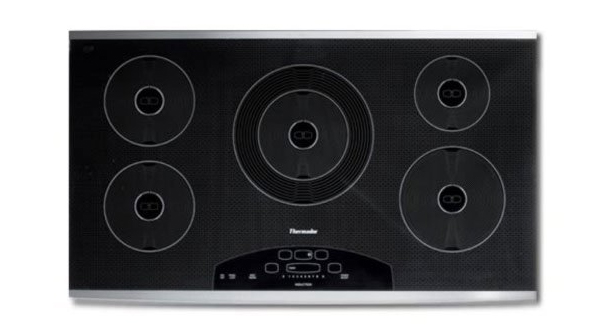Time to Replace Your Wolf Range?
Thermador induction cooktops are a highly efficient means of cooking. Powered by electricity, the cooktop uses magnetic induction, rather than electric resistance, to generate heat.
Induction Cooktops. Manufactured by Thermador.
One of the requirements of an induction cooktop is ferromagnetic cookware. Each "burner" contains an induction coil which generates a time-varying magnetic field. The magnetic field in turn induces an electrical current in the pot. This electrical current encounters resistance in the pot, which is not a perfect conductor, and this resistance is converted into heat which flows to the food. If non-magnetic cookware is used (e.g. most stainless steel, glass, aluminum) an electrical current will not flow, therefore no heat will be generated.
Induction cooktops are much more efficient than conventional cooktops, such as electric or gas models. While an electric or gas cooktop is operating, a significant percentage of the heat is lost to the ambient surroundings. It is estimated that with an electric or gas cooktop, less than 50% of the heat is actually transferred to the pot. However, with an induction cooktop, the pot itself, rather than the "burner", is the heat source, resulting in minimal heat loss to the ambient surroundings. The US Department of Energy and other groups have performed tests that show that between 80-90% of the heat is transferred to the pot. Induction cooktops typically consume about half as much electricity as electric resistance elements in order to provide the same amount of cooking.

The main drawbacks to induction cooktops are cost related. Typically, induction cooktops cost considerably more than electric or gas cooktops and sell for upwards of $2,500 to $3,000. This cost may come down as they increase in popularity. Additionally, a completely new set of cookware may be required if the existing cookware is not ferromagnetic.
Some additional benefits of induction cooktops are that they are safer to use, provide greater temperature control, and easy to clean. Since the cooktop itself does not generate any heat (only the pot/pan does), it can only get as hot as the cookware itself. In fact, if the induction cooktop was turned up to high, one could touch the element and it would feel as if it were at room temperature provided no cookware had been placed atop it. Since the cookware is the heating element, you receive faster reaction time to adjustments in temperature. And lastly, since the cooking surface is flat and smooth, induction cooktops are very easy to clean.




Leave a Reply